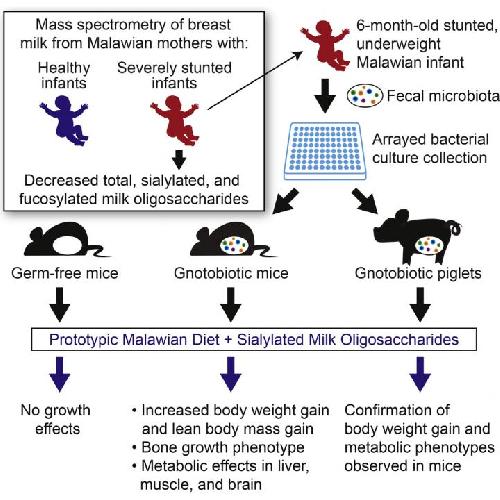Bacteria that live in the gut interact with dietary components to affect health and wellness. In a study published February 18 in Cell, a team led by Jeffrey Gordon at the Washington University School of Medicine in St. Louis now finds key components in breast milk that promote healthy infant growth and how interactions with the gut bacteria drive this process.
Childhood malnutrition causes over 3 million deaths every year and leads to stunted growth as well as deficits in immune and cognitive development. Partnering with colleagues in Malawi, Africa, where almost half of all children under five show stunted growth, the study's researchers obtained small samples of human breast milk from the mothers of healthy or stunted babies. They found that sugars containing sialic acid, which has been implicated in brain development, were far more abundant in the breast milk of mothers with healthy compared with stunted babies.
This suggested that these breast milk sugars might promote healthy infant growth. To determine if this was the case, the researchers established animal models that allowed both diet and the gut microbiome to be manipulated, since they found in a related study published concurrently in Science that gut microbes are important mediators of normal growth. Gordon and his team introduced a collection of bacterial strains isolated from the fecal sample of an undernourished infant into mice or piglets. The researchers then fed the animals a prototypical Malawian diet consisting of corn, legumes, vegetables, and fruit, which on its own is insufficient for healthy growth.
 This visual abstract shows how two preclinical models for infant undernutrition establish a link between consumption of sialylated milk oligosaccharides, the gut microbiota, and healthy growth. Credit: Charbonneau et al./Cell 2016
This visual abstract shows how two preclinical models for infant undernutrition establish a link between consumption of sialylated milk oligosaccharides, the gut microbiota, and healthy growth. Credit: Charbonneau et al./Cell 2016
With both the diet and microbiome mimicking those of undernourished Malawian infants transitioning to solid foods, the researchers then tested the effects of sialylated sugars. Given the difficulty of purifying large quantities of compounds from human breast milk, they turned instead to cow's milk, which contains sialylated sugars, but at 20-fold lower concentration than in breast milk. Through a complex series of steps, they isolated sialylated sugars from whey, a byproduct of cheesemaking, and fed it to the animals. Remarkably, the animals showed substantial improvements in growth, with increases in lean body mass and bone volume as well as metabolic changes in the liver, muscle, and brain suggesting improved ability to mobilize nutrients under diverse conditions. Crucially, these effects depended on the presence of the gut microbiota.
Since the assortment of gut bacteria that were isolated in this study were defined and could be grown in a dish, the authors were then able to tease out which bacteria were affected by sialylated sugars and how the different strains interacted with one another. They found that one species of bacteria fed on sialylated sugars, while another in turn fed on the digested products of those sugars, pointing to a food web among the bacterial community living in the gut. However, these two bacterial strains alone were not able to support healthy growth in mice; instead, more complex interactions between different types of gut bacteria were needed to promote growth.
This study lays the groundwork for identifying the components of breast milk that are needed for infant health and how they interact with the gut microbiome and other dietary components. The authors are excited to extend the approach to look at other mothers and babies to see how general their observations are. "This capacity to look in a very controlled way at how food is partitioned among members of a microbial community and how the metabolic output of that community can affect human biology is part of our ongoing agenda," Gordon says.
One possible application that may stem out of this work is improving infant formulas as well as therapeutic foods used to treat undernutrition, both of which are currently based on cow's milk and are therefore deficient in sialylated sugars. The researchers are hopeful, but careful to point out that more needs to be learned about how different types of bacteria interact with components of breast milk and complementary foods, and to ensure that harmful gut bacteria would not thrive on those components and thereby gain an advantage over beneficial microbes.
"Even though our intentions are good, we want to make sure we do no harm," Gordon says. "This is just the beginning of a long journey, an effort to understand how healthy growth is related to normal development of the gut microbiota, and how we can establish whether durable repair of microbiota immaturity may provide better clinical outcomes."
source: Cell Press